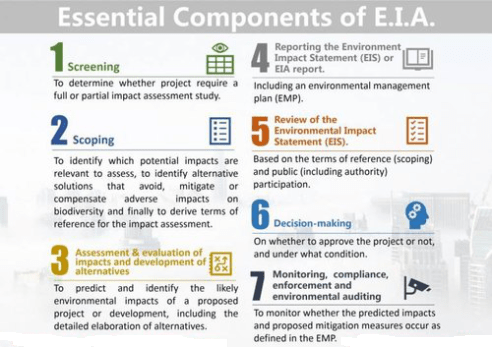What is the issue?
- The government has put up for public consideration and comment the Draft Environmental Impact Assessment (EIA) Notification, 2020.
- The draft is seen as an attempt to weaken environmental regulation and silence the affected communities.
What is EIA?
- The EIA process scrutinises the potential environmental impact of a project.
- It looks into the negative externalities of a proposed project i.e. before commencement.
- It then determines whether it can be carried out in the form proposed, or whether it is to be abandoned or modified.

How does it work?
- The assessment is carried out by an Expert Appraisal Committee (EAC).
- The EAC consists of scientists and project management experts.
- The EAC frames the scope of the EIA study and a preliminary report is prepared.
- The report is published, and a public consultation process takes place.
- During consultation, objections can be heard including from project-affected people.
- The EAC can then make a final appraisal of the project.
- It is then forwarded to the regulatory authority, which is the Ministry of Environment and Forests (MoEF).
- The regulatory authority is ordinarily obliged to accept the decision of the EAC.
What is the idea behind?
- The basis in global environmental law for the EIA is the “precautionary principle”.
- Environmental harm is often irreparable.
- It is thus cheaper to avoid damage to the environment than to remedy it.
- Various international environmental treaties and obligations as well as Supreme Court judgments are based on this principle.
- Environmental regulation must balance damage to the environment with sustainable development and possible benefits of a project.
- In this line, any project that involves environmental factors needs an unbiased assessment made on a precautionary basis.
- It is with this idea that the Environmental Impact Assessment is carried out.
- However, industries and business interests have long regarded EIA as a constraint to them.
What are the concerns with the recent notification?
- The stated reason is to streamline the EIA process and bring it in line with recent judgments.
- If put into force, the EIA Notification, 2020 will replace the EIA Notification, 2006 for all future projects.
- But the Draft EIA Notification dilutes the effectiveness of the process, and shrinks its scope.
- The most devastating blow to the EIA regime is the creation of an ex-post-facto clearance route.
- Under this, the project proponent can enter an assessment procedure, with some minor fines for the violations.
- In other words, it offers a route when an EIA clearance is not sought or granted, and the construction of the project had taken place.
- Where such ex-post-facto clearances were being granted previously, the courts cracked down on them as illegal.
- Therefore, what could not be ratified will now find itself notified.
- The legality of sidestepping the courts is questionable and will have to be tested.
- In essence, the EIA would become a business decision as to whether the law needs to be followed or the violation can be “managed”.
- The argument that this route will be an “exception” is difficult, given the long history of expanding the exception into the rule.
- The draft notification also shortens the time for the public to furnish responses on the project.
- The project-affected people are frequently forest dwellers.
- For these and others who do not have access to information and technology, this will make it harder to put forth representations.
- Monitoring requirements have also been relaxed.
- The draft EIA notification halves the frequency of reporting requirements from every 6 months to once a year.
- It also extends the validity period for approvals in critical sectors such as mining.
- The scope of the EIA regime is also set to shrink.
- Industries that previously fell under the categories that required a full assessment have been downgraded.
- The construction industry will be one such beneficiary, where only the largest projects will be scrutinised fully.
- Defence and national security installations were always understandably exempt.
- But, a vague new category of projects “involving other strategic considerations” will also now be free from public consultation requirements.
How serious is this?
- A deadly gas leak at LG Polymers’ Visakhapatnam plant in May 2020 killed 12 people and harmed hundreds.
- What came to light after the disaster was that the plant had been operating without a valid environmental clearance for decades.
- Given such incidents, weakening the EIA process is essentially anti-democratic.
- Seismic shifts in the local environment can threaten livelihoods, flood a valley or destroy a forest.
- For affected communities, public consultation is a referendum on such existential threats.
- To curtail this is to silence the voices that are scarcely heard otherwise.
- It seems that the government views environmental regulation as an impediment to the ease of doing business.
- During the nationwide coronavirus-led lockdown, the MoEF has been working swiftly to clear projects.
- It is even carrying out public hearings over video conference.
- Notably, the Minister for Environment and Forests and the Minister for Heavy Industries and Public Enterprises is the same person now.
- Two charges that are oppositional are vested with the same person and the resultant conflict of interest is debatable.
Source: Indian Express
